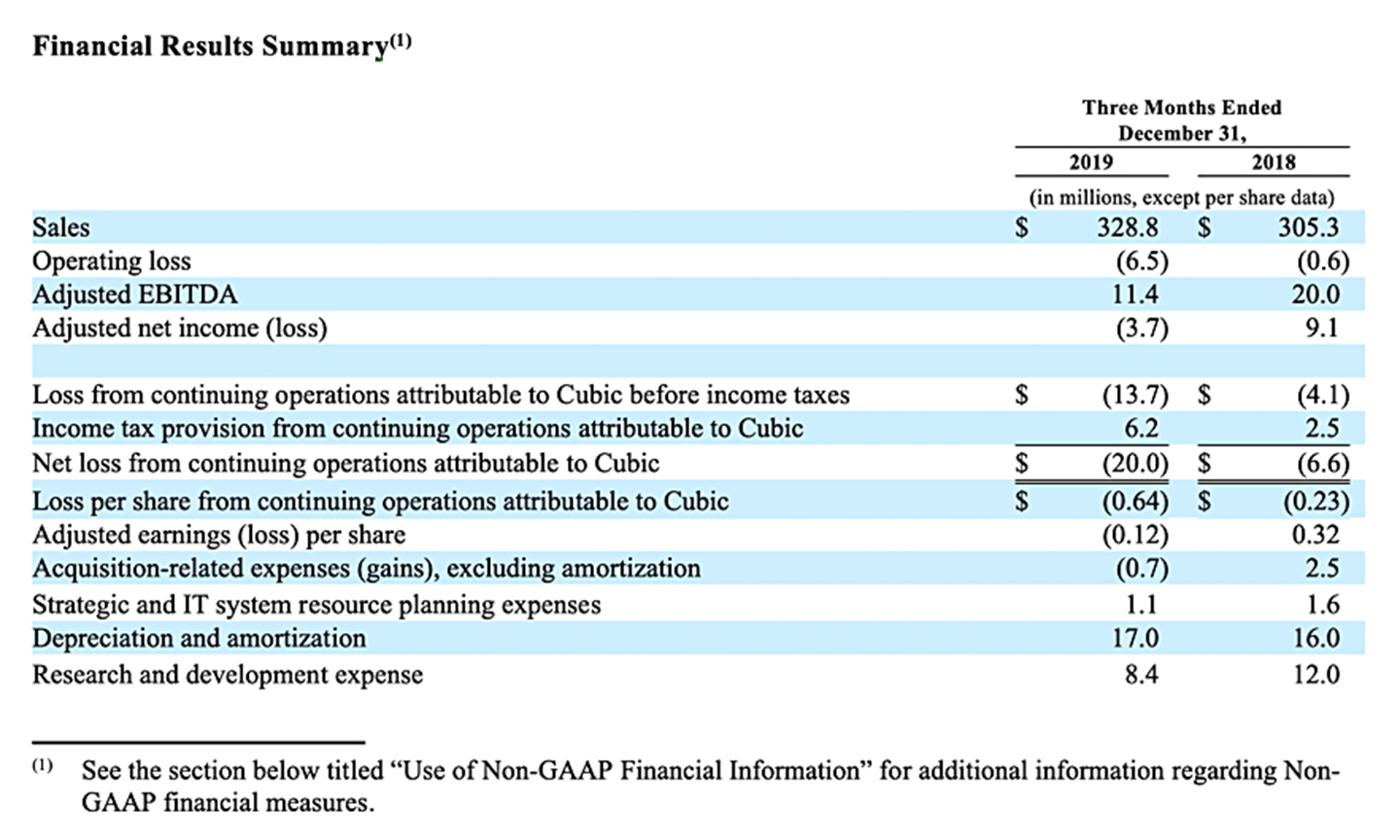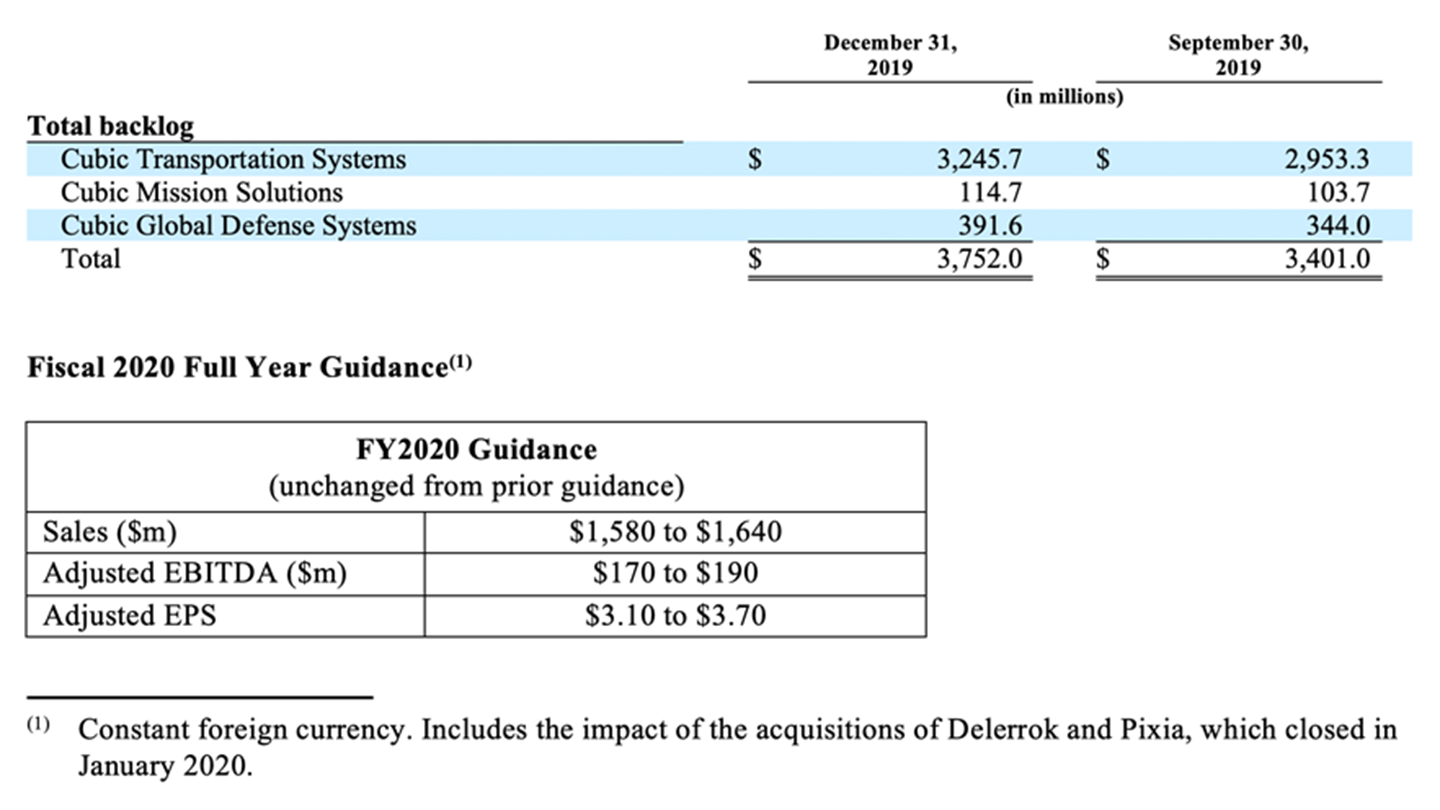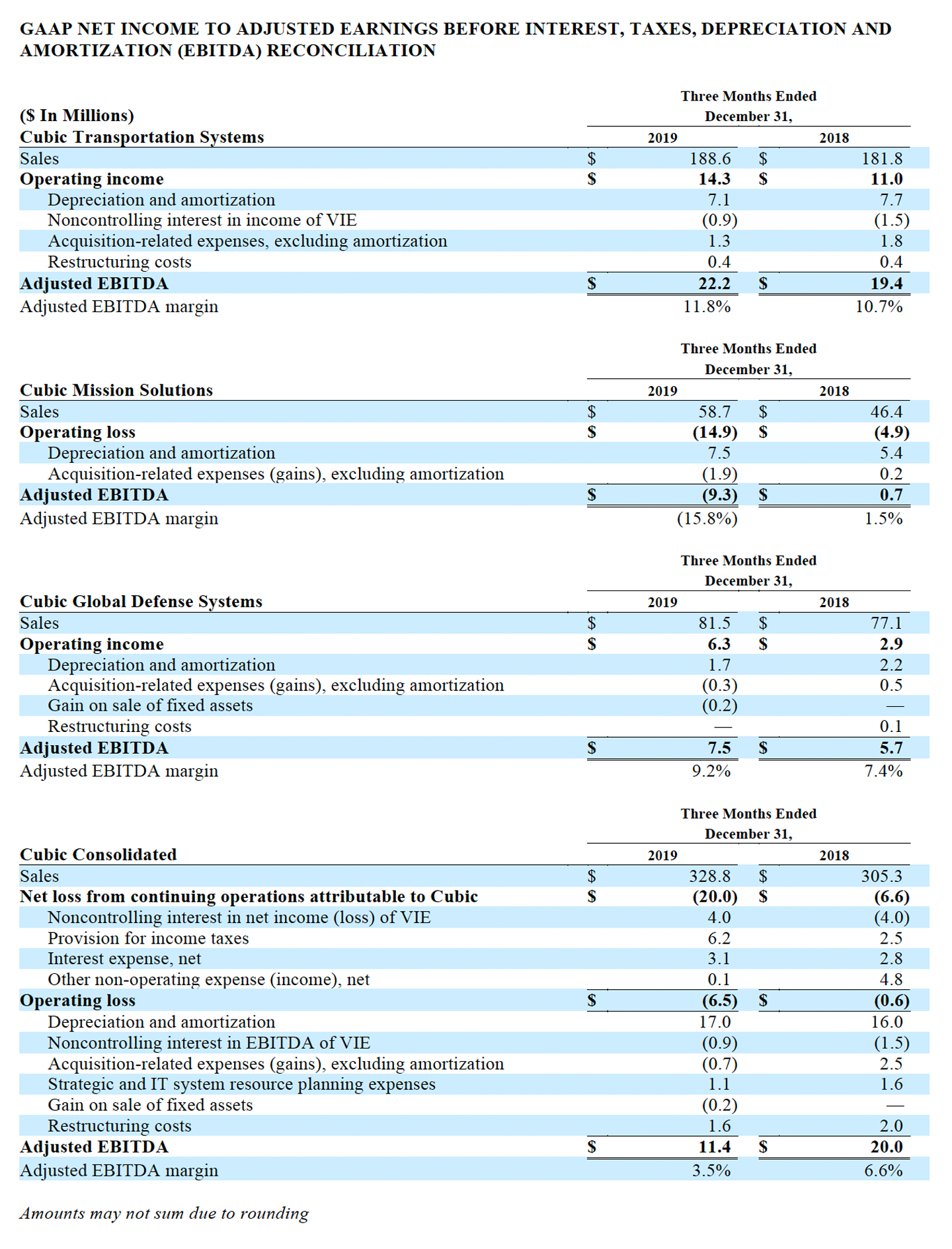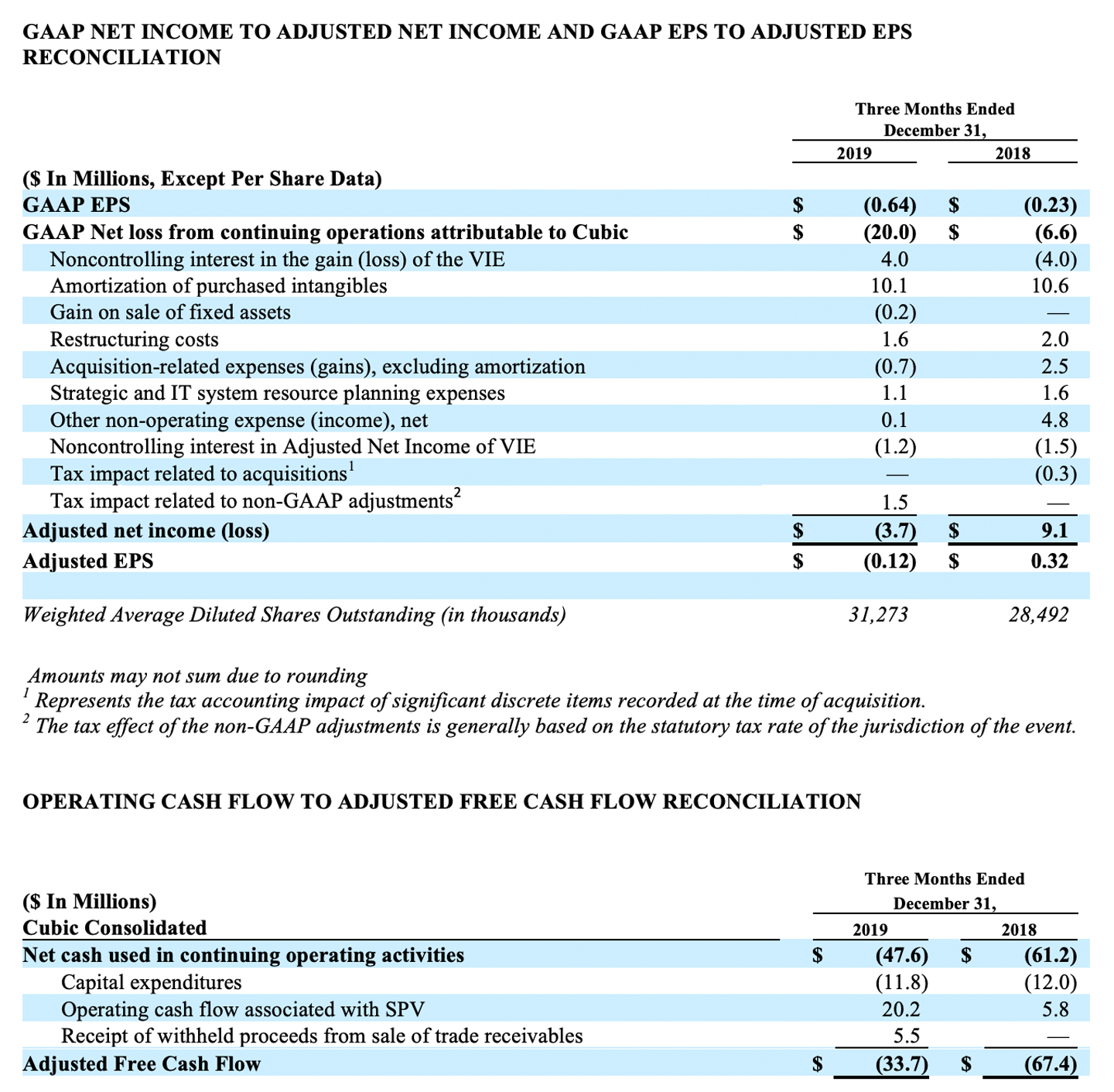SAN DIEGO – February 5, 2020 – Cubic Corporation (NYSE: CUB) today announced its financial results for the first quarter ended December 31, 2019.
First Quarter Fiscal Year 2020 Highlights
- Sales of $328.8 million, up 8% year-over-year
- Net loss from continuing operations attributable to Cubic of $20.0 million, or $0.64 per share, compared to $6.6 million, or $0.23 per share in the first quarter of fiscal 2019
- Adjusted EPS of ($0.12) per share, compared to $0.32 per share in the first quarter of fiscal 2019
- Adjusted EBITDA of $11.4 million, compared to $20.0 million in the first quarter of fiscal 2019
- Signed definitive agreement with Moovit to co-develop next-generation mobile solutions
- Closed Pixia and Delerrok acquisitions, advancing NextMissionTM and NextCityTM strategies
- Reaffirmed fiscal 2020 guidance: Sales $1,580 to $1,640 million; Adjusted EBITDA $170 to $190 million; Adjusted EPS $3.10 to $3.70
“I am pleased with our first quarter sales growth and additional contract wins across each business, while we continued to make incremental growth investments in Cubic Mission Solutions,” said Bradley H. Feldmann, chairman, president and chief executive officer of Cubic Corporation. “We remain focused on delivering on Cubic’s strategic growth plan and we are confident in the full year outlook, which is supported by our large backlog in transportation, recent bookings in defense training and continued robust demand in C4ISR.”
Consolidated First Quarter Fiscal Year 2020 Results
Sales for the first quarter of fiscal 2020 increased 8% as reported and 6% on an organic basis to $328.8 million, compared to $305.3 million in the first quarter of fiscal 2019, reflecting growth in all three segments.
Operating loss in the first quarter of fiscal 2020 was $6.5 million, compared to $0.6 million in the first quarter of fiscal 2019. The increase in operating loss was largely driven by incremental growth investments in the Missions Solutions segment. Additionally, unallocated corporate expenses increased to $12.2 million, compared to $9.6 million in the first quarter of fiscal 2019, primarily driven by an increase in stock-based compensation expense.
Adjusted EBITDA in the first quarter of fiscal 2020 decreased to $11.4 million, compared to $20.0 million in the first quarter of fiscal 2019, primarily due to the same factors that drove a higher operating loss.
Net loss from continuing operations attributable to Cubic in the first quarter of fiscal 2020 was $20.0 million, or $0.64 per share, compared to $6.6 million in the first quarter of fiscal 2019, or $0.23 per share, reflecting an increase in operating loss and higher taxes. The effective tax rate was negative 64%, compared to negative 31% for the first quarter of fiscal 2019 and the statutory rate of 21%. The tax expense recognized on the pre-tax loss was primarily due to jurisdictional mix of earnings and an increase in US BEAT and state cash tax expense.
Adjusted net loss was $3.7 million, or $0.12 per share, in the first quarter of fiscal 2020, compared to Adjusted net income of $9.1 million, or $0.32 per share, in the first quarter of fiscal 2019, reflecting lower Adjusted EBITDA and an increase in taxes and depreciation expense.
Net cash used in continuing operations was $47.6 million in the first quarter of fiscal 2020, compared to $61.2 million in the first quarter of fiscal 2019. Adjusted Free Cash Flow improved to negative $33.7 million in the first quarter of fiscal 2020, compared to negative $67.4 million in the first quarter of fiscal 2019.
Cubic Transportation Systems (CTS)
CTS sales increased 4% to $188.6 million in the first quarter of fiscal 2020, compared to $181.8 million in the first quarter of fiscal 2019. Organic sales growth of 2% was primarily driven by system development related to our Brisbane, San Francisco Bay Area and Boston next-generation fare payment systems contracts. CTS Adjusted EBITDA increased 14% to $22.2 million in the first quarter of fiscal 2020, compared to $19.4 million in the first quarter of fiscal 2019, reflecting lower research and development expense and higher sales.
Cubic Mission Solutions (CMS)
CMS sales increased 27% to $58.7 million in the first quarter of fiscal 2020, compared to $46.4 million in the first quarter of fiscal 2019. Organic sales growth of 20% reflects increased deliveries in all CMS product lines, particularly expeditionary satellite communications and other secure communications products. CMS Adjusted EBITDA decreased to negative $9.3 million in the first quarter of fiscal 2020, compared to $0.7 million in the first quarter of fiscal 2019. Adjusted EBITDA reflects incremental growth investments related to our Troposcatter and MQ-25 contracts.
Cubic Global Defense Systems (CGD)
CGD sales increased 6% on a reported and organic basis to $81.5 million in the first quarter of fiscal 2020, compared to $77.1 million in the first quarter of fiscal 2019, primarily due to increased work on air combat training systems. CGD Adjusted EBITDA increased 32% to $7.5 million in the first quarter of fiscal 2020, compared to $5.7 million in the first quarter of fiscal 2019, reflecting cost savings initiatives and higher sales.
Backlog
Backlog increased by $351.0 million from September 30, 2019 to December 31, 2019, primarily due to an award for a five-year extension to upgrade Chicago’s Ventra fare collection system. Foreign currency had a favorable impact of $76.1 million.
Conference Call and Webcast Information
Date: February 5, 2020
Time: 5:00 p.m. ET
Hosts: Bradley H. Feldmann, Chairman, President and Chief Executive Officer
Anshooman Aga, Executive Vice President and Chief Financial Officer
Dial in: 844-603-5091
825-312-2261 (international)
Conference ID 3428348
Webcast: https://event.on24.com/wcc/r/2151353/6792785B46783D5C362AB8A8D093E723
An archive of the webcast will be made available on the Investor Relations section of the company’s website: https://www.cubic.com/investor-relations/financials.
About Cubic Corporation
Cubic is a technology-driven, market-leading provider of integrated solutions that increase situational understanding for transportation, defense C4ISR and training customers worldwide to decrease urban congestion and improve the militaries’ effectiveness and operational readiness. Our teams innovate to make a positive difference in people’s lives. We simplify their daily journeys. We promote mission success and safety for those who serve their nation. For more information about Cubic, please visit www.cubic.com or on Twitter @CubicCorp.
Forward-Looking Statements
This press release contains forward-looking statements within the meaning of the Private Securities Litigation Reform Act of 1995 that are subject to the safe harbor created by such Act. Forward-looking statements include, among others, statements about our expectations regarding future events or our future financial and/or operating performance, including achieving our fiscal 2020 full year guidance and delivering on our strategic growth plan. These statements are often, but not always, made through the use of words or phrases such as “may,” “will,” “anticipate,” “estimate,” “plan,” “project,” “continuing,” “ongoing,” “expect,” “believe,” “intend,” “predict,” “potential,” “opportunity” and similar words or phrases or the negatives of these words or phrases. These statements involve risks, estimates, assumptions and uncertainties that could cause actual results to differ materially from those expressed in these statements, including, among others: our dependence on U.S. and foreign government contracts; delays in approving U.S. and foreign government budgets and cuts in U.S. and foreign government defense expenditures; the ability of certain government agencies to unilaterally terminate or modify our contracts with them; our assumptions covering behavior by public transit authorities; our ability to successfully integrate new companies, including Trafficware, GRIDSMART, Nuvotronics, Delerrok and Pixia into our business and to properly assess the effects of such integration on our financial condition and operating results; the U.S. government’s increased emphasis on awarding contracts to small businesses, and our ability to retain existing contracts or win new contracts under competitive bidding processes; negative audits by the U.S. government; the effects of politics and economic conditions on negotiations and business dealings in the various countries in which we do business or intend to do business; competition and technology changes in the defense and transportation industries; the change in the way transit agencies pay for transit systems; our ability to accurately estimate the time and resources necessary to satisfy obligations under our contracts; the effect of adverse regulatory changes on our ability to sell products and services; our ability to identify, attract and retain qualified employees; unforeseen problems with the implementation and maintenance of our information systems, including our new ERP system; business disruptions due to cyber security threats, physical threats, terrorist acts, acts of nature and public health crises; our involvement in litigation, including litigation related to patents, proprietary rights and employee misconduct; our reliance on subcontractors and on a limited number of third parties to manufacture and supply our products; our ability to comply with our development contracts and to successfully develop, introduce and sell new products, systems and services in current and future markets; defects in, or a lack of adequate coverage by insurance or indemnity for, our products and systems; changes in U.S. and foreign tax laws, exchange rates or our economic assumptions regarding our pension plans; and we may not be able to achieve our fiscal 2020 guidance. In addition, please refer to the risk factors contained in our SEC filings available at www.sec.gov, including our most recent Annual Report on Form 10-K and Quarterly Report on Form 10-Q. Because the risks, estimates, assumptions and uncertainties referred to above could cause actual results or outcomes to differ materially from those expressed in any forward-looking statements, you should not place undue reliance on any forward-looking statements. Any forward-looking statement speaks only as of the date hereof, and, except as required by law, we undertake no obligation to update any forward-looking statement to reflect events or circumstances after the date hereof.
Use of Non-GAAP Financial Information
In addition to results reported under GAAP, we provide certain non-GAAP measures. These non-GAAP measures consist of organic sales growth, Adjusted net income, Adjusted earnings per share (Adjusted EPS), Adjusted EBITDA and Adjusted Free Cash Flow. We believe that these non-GAAP measures provide additional insight into our ongoing operations and underlying business trends, facilitate a comparison of our results between current and prior periods, and facilitate the comparison of our operating results with the results of other public companies that provide non-GAAP measures. We use Adjusted EBITDA internally to evaluate the operating performance of our business, for strategic planning purposes, and as a factor in determining incentive compensation for certain employees. These non-GAAP measures facilitate company-to-company operating comparisons by excluding items that we believe are not part of our core operating performance. Organic sales growth is defined as the year-over-year percentage change in reported sales relative to the prior comparable period, excluding the impact of acquisitions and divestitures over the prior 12 months and the impact of foreign currency translation. Adjusted EBITDA is defined as GAAP net income from continuing operations attributable to Cubic before interest expense, income taxes, depreciation and amortization, other non-operating expense, acquisition-related expenses, strategic and IT system resource planning expenses, restructuring costs, and gains or losses on the disposal of fixed assets. Adjusted net income is defined as GAAP net income from continuing operations attributable to Cubic excluding amortization of purchased intangibles, restructuring costs, acquisition related expenses, strategic and IT system resource planning expenses, gains or losses on the disposal of fixed assets, other non-operating expense (income), tax impacts related to acquisitions, and the impact of U.S. Tax Reform. Adjusted EPS is defined as Adjusted net income on a per share basis using the weighted average diluted shares outstanding. Strategic and IT system resource planning expenses consists of expenses incurred in the development of our ERP system and the redesign of our supply chain which include internal labor costs and external costs of materials and services that do not qualify for capitalization. Acquisition-related expenses include business acquisition expenses including retention bonus expenses, due diligence and consulting costs incurred in connection with the acquisitions, and expenses recognized related to the change in the fair value of contingent consideration for acquisitions.
Adjusted Free Cash Flow is defined as Net cash provided by continuing operations, excluding operating cash flow associated with the Boston Special Purpose Vehicle (SPV) in which Cubic has a 10% equity stake, less capital expenditures plus proceeds from the sale of fixed assets and the receipt of withheld proceeds from the sale of trade receivables. The Boston SPV has contracted with Cubic for the design-build and operations and maintenance phases of the next-generation fare collection system for the Massachusetts Bay Transit Authority and pays Cubic progress payments during the design-build phase of the project. These payments are primarily funded by non-recourse debt issued by the SPV. Additional information regarding the company’s Boston SPV can be found in our Annual Report on Form 10-K for the year ended September 30, 2019. Management believes that Adjusted Free Cash Flow is meaningful to investors because management reviews cash flows generated from operations after taking into consideration capital expenditures, which are necessary to maintain and expand Cubic’s business, in addition to the other adjustments noted above. Adjusted Free Cash Flow does not represent the residual cash flow available for discretionary expenditures since other non-discretionary expenditures are not deducted from the measure.
These non-GAAP measures are not measurements of financial performance under GAAP and should not be considered as measures of discretionary cash available to the company or as alternatives to net income as a measure of performance. In addition, other companies may define these non-GAAP measures differently and, as a result, our non-GAAP measures may not be directly comparable to the non-GAAP measures of other companies. Furthermore, non-GAAP financial measures have limitations as an analytical tool and you should not consider these measures in isolation, or as a substitute for analysis of our results as reported under GAAP. Investors are advised to carefully review our GAAP financial results that are disclosed in our SEC filings. With respect to our fiscal year 2020 Adjusted EBITDA and Adjusted EPS guidance, certain items that affect GAAP net income cannot be reasonably predicted as we are unable to quantify certain amounts that would be required to be included in the comparable forecasted GAAP measures without unreasonable effort. As such, we are unable to provide a reasonable estimate of GAAP net income or GAAP EPS, or a corresponding reconciliation of Adjusted EBITDA and Adjusted EPS guidance to GAAP net income or GAAP EPS for the full year. In addition, we believe such reconciliations would imply a degree of precision that would be confusing or misleading to investors.
We reconcile organic sales growth to sales growth as reported, which we consider to be the most directly comparable GAAP financial measure. We reconcile Adjusted EBITDA and Adjusted net income to GAAP net income, which we consider to be the most directly comparable GAAP financial measure. We reconcile Adjusted EPS to GAAP EPS, which we consider to be the most directly comparable GAAP financial measure. We reconcile Adjusted Free Cash Flow to Net cash provided by continuing operations, which we consider to be the most directly comparable GAAP financial measure. The following tables reconcile these non-GAAP measures to their most directly comparable GAAP financial measure.
Media Contact
Laura Chon
Corporate Communications
Cubic Corporation
PH: +1 858-505-2181
Laura.Chon@cubic.com
Investor Contact
Kirsten Nielsen
Investor Relations
Cubic Corporation
PH +1 212-331-9760
Kirsten.Nielsen@cubic.com





